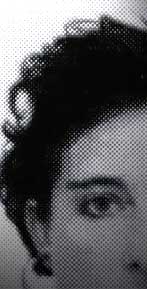Eléonore BAK
Eléonore BAK is a teacher and plastic artist
of sound : theory and production are linked, university master, scenic
performances, museal installations, the sounds volumes are inscribed
within space.
The research is the affirmation of writing modules that aim at the widening
of the sensitive.
Professeur et artiste plasticienne du son : théorie et production
sont liées, maîtrise d'université, performances
scéniques, installations muséales, les volumes sonores
s'inscrivent dans les lieux, formulent le site. La recherche affirme
des modules d'écriture, vise l'élargissement du sensible.

|
|
The art of sound exists like any other art forms
through the immediacy of the unpredictability of its artistic content.
I propose to approach the new possibilities that the universe of sound
offers, without being overpowered by the fascination of the most advanced
technology - and perhaps more subject to time than we would like to
think. We live in an ever expanding world in which real space seems
to be reduced as the world population grows. But we need to enlarge
and preserve our vital space. To do that we need to find the means beyond
material space and be more open to the space of sound.
The space of sound is real, it is not virtual. Sounds have surrounded
us since the world exists. They slip away because we are not attentive
enough, they give off a polluting feature when we ignore their effects.
If we were to perceive sounds more attentively, if we would try to control
them, then we would have a loose open field to the ultimate propagation.
In sharpening our perceptive faculties, we are making a change that
pulls us out of the guardianship of images therefore opening a universe
that has been ignored and neglected by other sensorial abilities giving
us a wider observation of universal space.
Art and life, creativity and receptiveness are intimately linked. Sound
work demands a stronger complicity between the audience and the artist
than any other artistic expression.
The plastic sound is totally dependant of the radicalness of the non-seeing.
The fragileness of sound is put forth by the fact that it is dependant
on the perceptive ability of the audience. I will equally underline
its ephemerous consistency one that privileges an immediate experience.
Maybe more than any other artistic
expression, sound brings forth the effect of time in artistic practice
as it does on our own existence when we escape collecting and generalising.
What could be understood as a weakness is in fact the guarantee of its
eternal reawakening. The constantly renewed act of listening works for
the individual
because it participates in the experience of life.
The art of Sound begins with the art of listening.
Eleonore Bak
Nice, 1997.
L'art
du son n'est pas l'accumulation d'un répertoire technique ni
d'un recensement original de ses racines. Il existe comme toute autre
forme d'art par l'immédiateté dans l'imprévisibilité
de son contenu artistique.
Je me propose d'approcher les nouvelles possibilités que l'univers
du Son nous offre, sans pour autant succomber à la fascination
de la technologie la plus avancée - et peut-être de ce
fait la plus soumise au temps. Nous vivons dans un monde en permanente
expansion, l'espace réel semble se réduire au fur et à
mesure que la population mondiale croît. Mais nous avons besoin
d'élargir et de conserver notre espace vital; pour ce faire nous
devons chercher des moyens au-delà de l'espace matériel,
l'ouverture à l'espace du Son encore davantage.
L'espace du Son est réel et non pas virtuel. Les Sons nous entourent
depuis que le monde existe. Ils nous échappent parce que nous
n'y prêtons pas attention, ils dégagent un caractère
polluant quand nous ignorons leurs effets.
Si nous les percevons attentivement, si nous nous efforcons de les maîtriser,
nous disposerons d'un terrain dont les étendues se perdent dans
la propagation ultime.
Aiguiser nos facultés perceptives nous sort de la tutelle de
l'image mais nous offre l'univers ignoré et négligé
de nos autres facultés sensorielles qui nous permettent d'observer
une plus grande partie de l'espace universel.
L'art et la vie, la créativité et la réceptivité
sont intimement liés et le travail du Son demande encore plus
que les autres expressions artistiques une complicité énergique
entre le public et l'artiste.
Le Son plastique est tout à fait dépendant de la radicalité
du "non-voir".
La fragilité du Son est mise en évidence par le fait même
qu'il dépend de la faculté de perception du public. Je
soulignerais également sa consistance éphémère
qui privilégie le vécu immédiat. Plus que toute
autre expression artistique peut-être, le Son met en évidence
l'effet temps sur la pratique des arts comme sur notre propre existence,
en échappant à la collection, et à la généralisation.
Ce qui pourrait être compris comme une faiblesse est en fait la
garantie de son éternelle régénérescence
par l'écoute constamment renouvelée, y compris pour l'individu
puisque l'écoute participe de l'expérience de la vie.
L'art du Son commence avec l'art de l'écoute. Nice, 1997.
|
